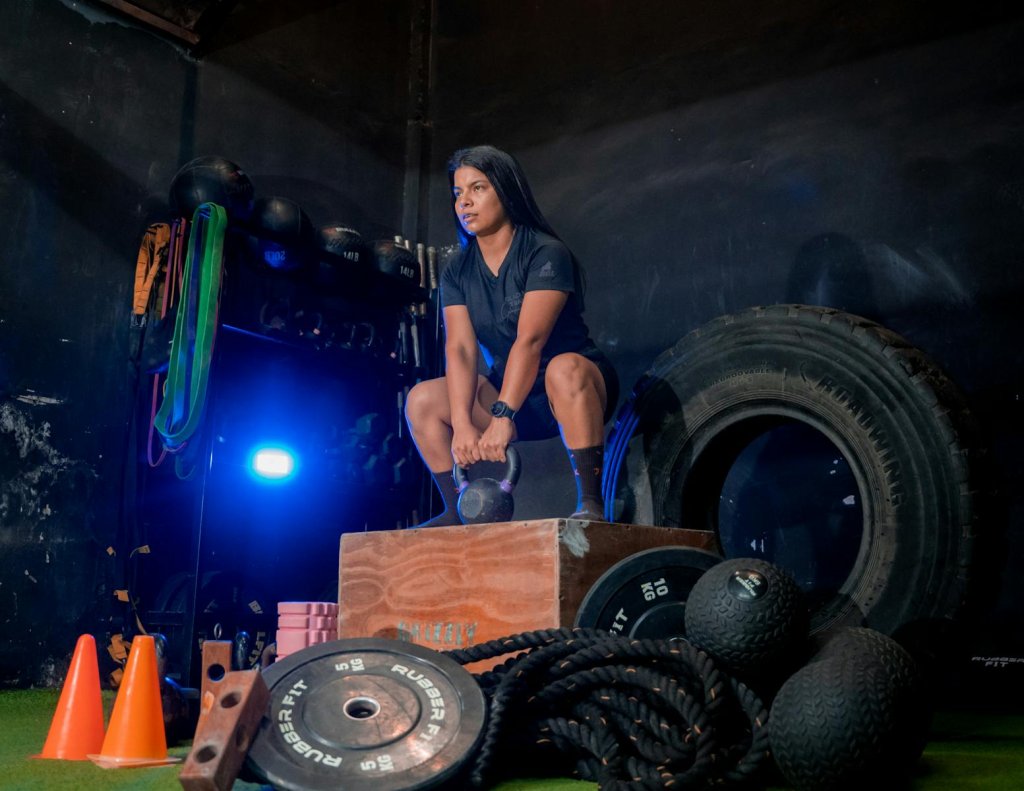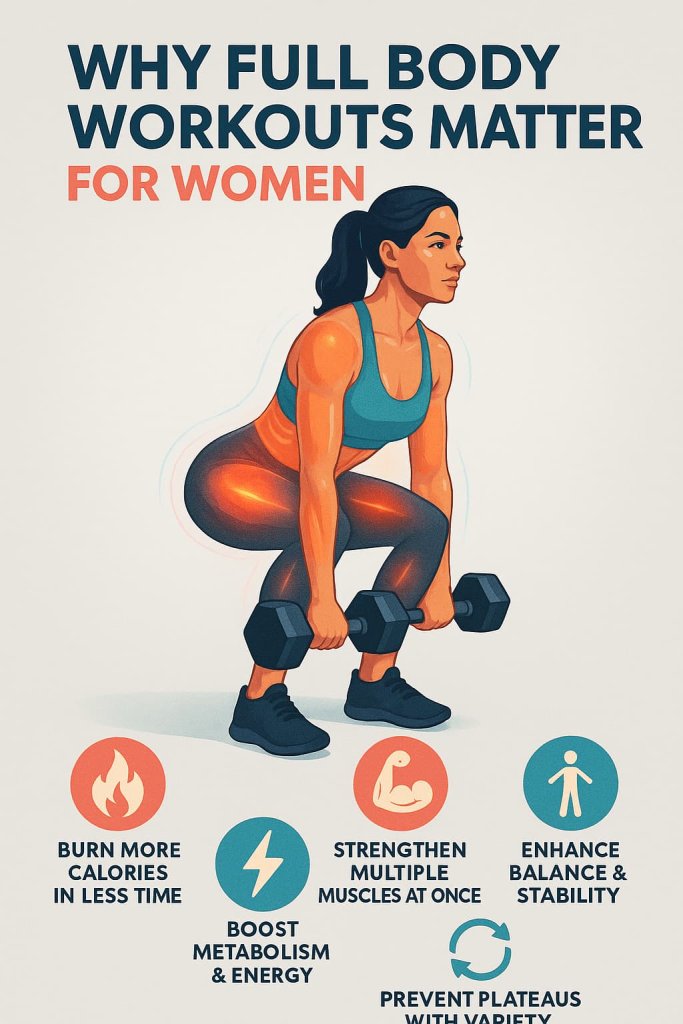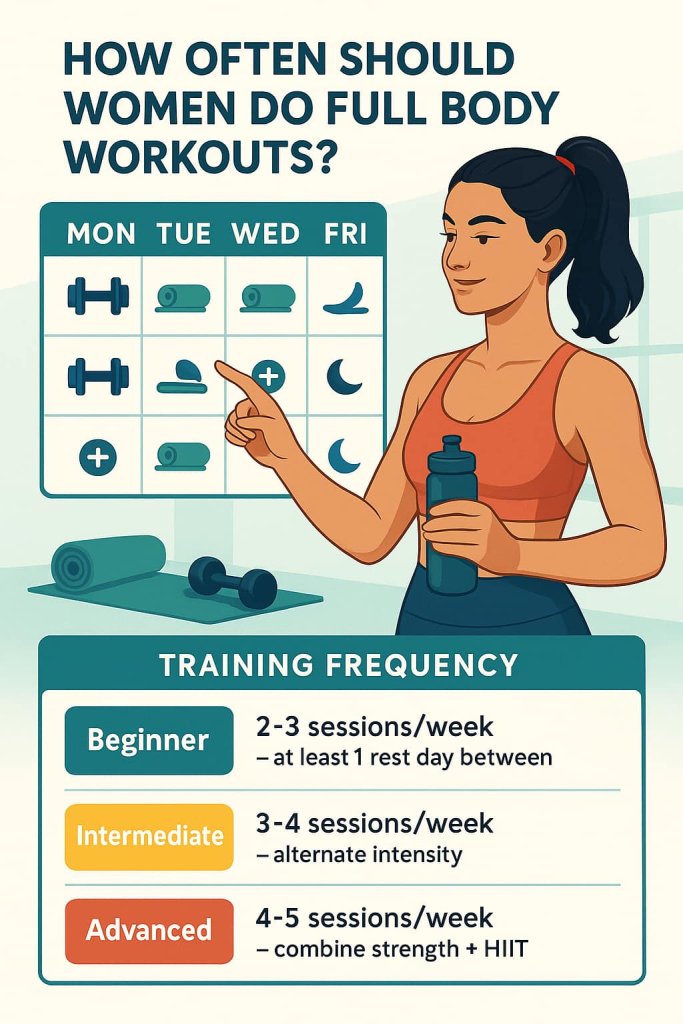The best full body workouts for women combine strength training, cardio, and functional movement to burn fat, build lean muscle, and enhance total-body tone.
Unlike isolated routines, full-body workouts target all major muscle groups — legs, glutes, core, arms, and shoulders — in one efficient session.

Understanding how to train your whole body helps you maximize calorie burn, improve metabolism, and build balanced strength. Whether you’re exercising at home or in the gym, these workouts are designed for visible, lasting results.
Why Full Body Workouts Matter for Women
Full-body training delivers three major benefits: efficiency, balance, and total strength.
According to the American Council on Exercise, full-body strength sessions stimulate a higher post-exercise oxygen consumption (EPOC), meaning you keep burning calories long after your workout ends.

Key benefits:
- Burn more calories in less time
- Strengthen multiple muscles in one session
- Enhance joint stability and posture
- Boost metabolism and energy
- Prevent plateaus by varying intensity and movement
Evidence shows that, when weekly training volume is matched, full-body and split routines deliver similar strength and muscle gains in women—so choose the style you can sustain consistently.
How Often Should Women Do Full Body Workouts?

- Beginners: 2–3 sessions per week with at least 1 rest day in between
- Intermediate: 3–4 sessions per week, alternating intensity levels
- Advanced: 4–5 sessions per week, incorporating strength and HIIT
Each session should last 30–45 minutes, balancing compound strength moves with moderate-intensity cardio or circuit training.
15 Best Full Body Workouts for Women
Below are science-backed workouts combining functional, strength, and fat-burning movements. You can rotate them weekly or combine 4–6 into a customized plan.
1. Dumbbell Squat to Press
Why it works:
This compound exercise engages both lower and upper body simultaneously, building total-body strength and coordination. It enhances functional movement patterns while boosting heart rate for fat burn.
Muscles worked: Quads, glutes, shoulders, triceps, core.
How to do it:
- Stand with feet shoulder-width apart, holding dumbbells at shoulder height.
- Lower into a squat, keeping your chest tall and knees aligned with toes.
- As you stand up, drive through your heels and press the dumbbells overhead.
- Lower weights back to shoulders and repeat for 10–12 reps.
Trainer Tip:
Exhale as you press overhead and maintain a tight core throughout the movement to protect your lower back.
2. Reverse Lunge with Bicep Curl
Why it works:
This move challenges your balance, coordination, and strength by combining a lower-body lunge with upper-body curls. It improves stability and joint control while sculpting arms and legs.
Muscles worked: Glutes, hamstrings, biceps, core.
How to do it:
- Stand tall with dumbbells at your sides.
- Step one foot back into a deep lunge.
- As you lower, perform a bicep curl with both arms.
- Return to standing and switch legs. Perform 10 reps per side.
Trainer Tip:
Keep your elbows close to your torso to isolate the biceps and avoid swinging the weights.
3. Push-Up to Row
Why it works:
This powerful combination move develops upper-body strength, core stability, and shoulder balance. It mimics athletic pushing and pulling patterns in one seamless flow.
Muscles worked: Chest, triceps, lats, abs, shoulders.
How to do it:
- Start in a plank position holding dumbbells directly under your shoulders.
- Perform a push-up, lowering chest to floor.
- As you rise, row one dumbbell toward your rib cage.
- Alternate sides for 8–10 total rows.
Trainer Tip:
Keep your hips square to the floor — if your body twists, reduce weight to maintain proper form.
4. Romanian Deadlift
Why it works:
Strengthens the posterior chain — essential for better posture, glute development, and injury prevention. It also increases hip hinge mobility and hamstring flexibility.
Muscles worked: Hamstrings, glutes, lower back, core.
How to do it:
- Hold dumbbells in front of your thighs, palms facing in.
- Keep a soft bend in knees and hinge at hips, lowering weights until you feel tension in hamstrings.
- Drive hips forward to stand tall, squeezing glutes at the top.
Trainer Tip:
Focus on hip movement, not knee bending — the key is to push your hips back, not squat.
5. Jump Squats
Why it works:
A plyometric move that builds explosive power while torching calories. It enhances lower-body strength and coordination, making it ideal for metabolic conditioning.
Muscles worked: Quads, glutes, calves, core.
How to do it:
- Perform a deep squat.
- Explosively jump upward, swinging arms for momentum.
- Land softly with knees slightly bent and go straight into the next rep.
Trainer Tip:
Engage your core and keep your landings controlled to reduce joint impact.
6. Renegade Row with Push-Up
Why it works:
Combines pushing and pulling in one challenging exercise, improving total upper-body endurance and core control. Great for building functional strength.
Muscles worked: Back, chest, abs, triceps, shoulders.
How to do it:
- Start in a plank with dumbbells under shoulders.
- Lower into a push-up.
- As you come up, row one dumbbell to your ribs.
- Alternate arms for 8–10 reps each side.
Trainer Tip:
Widen your stance for more balance and avoid swinging your torso during rows.
7. Burpees
Why it works:
A full-body cardio powerhouse that increases endurance, burns fat, and improves coordination. It mimics athletic movements and boosts stamina quickly.
Muscles worked: Chest, shoulders, legs, glutes, core.
How to do it:
- From standing, squat down and place hands on the floor.
- Jump feet back into a push-up position, perform one push-up.
- Jump feet back toward hands and explode upward.
Trainer Tip:
Modify by stepping instead of jumping if you’re a beginner, focusing on smooth transitions.
8. Step-Ups with Dumbbells
Why it works:
Enhances unilateral leg strength and balance, reducing muscle imbalances between sides. Also mimics everyday movements like climbing stairs.
Muscles worked: Glutes, quads, calves, core.
How to do it:
- Hold dumbbells at your sides and step one foot onto a sturdy bench or box.
- Push through your front heel to stand tall.
- Slowly lower back down and switch legs. Perform 10–12 reps per leg.
Trainer Tip:
Keep your knee aligned with your ankle and avoid using momentum from your back leg.
9. Plank with Shoulder Tap
Why it works:
Improves shoulder stability, core strength, and balance. This move teaches your body to resist rotation — key for strong abs and lower-back protection.
Muscles worked: Abs, shoulders, glutes, chest.
How to do it:
- Start in a high plank with hands under shoulders.
- Tap your right hand to your left shoulder, then alternate.
- Continue for 30–45 seconds, maintaining tight core engagement.
Trainer Tip:
Keep your feet slightly wider for stability and avoid letting hips sway side to side.
10. Kettlebell Swings
Why it works:
Develops explosive hip drive, strengthens glutes and hamstrings, and boosts conditioning. It also improves posture and cardiovascular fitness.
Muscles worked: Glutes, hamstrings, core, shoulders, back.
How to do it:
- Stand with feet shoulder-width apart, holding a kettlebell with both hands.
- Swing it between your legs, then powerfully extend hips to swing it to chest height.
- Let it swing back naturally and repeat rhythmically.
Trainer Tip:
Use your hips — not arms — to generate power. Maintain a neutral spine throughout.
11. Mountain Climbers
Why it works:
A cardio-core hybrid move that improves endurance and coordination while strengthening the abs and hip flexors.
Muscles worked: Core, shoulders, glutes, legs.
How to do it:
- Begin in a plank position.
- Drive one knee toward your chest, then quickly switch legs.
- Keep your pace brisk for 30–60 seconds.
Trainer Tip:
Keep shoulders stacked over wrists and hips level — avoid bouncing up and down.
12. Glute Bridge March
Why it works:
Strengthens glutes and hamstrings while improving hip stability. It also activates your core and lower back for balance.
Muscles worked: Glutes, hamstrings, abs, lower back.
How to do it:
- Lie on your back with knees bent and feet flat.
- Lift hips into a bridge, forming a straight line from shoulders to knees.
- Lift one knee toward your chest, lower it, and switch sides.
Trainer Tip:
Drive through your heels and avoid arching your lower back.
13. Side Plank with Hip Lift
Why it works:
Targets obliques, improves core balance, and enhances lateral hip strength. It’s excellent for building stability and posture.
Muscles worked: Obliques, glutes, shoulders, abs.
How to do it:
- Lie on one side with elbow under shoulder.
- Lift hips until body forms a straight line.
- Drop hips slightly and lift back up for 12–15 reps per side.
Trainer Tip:
Keep your neck neutral and avoid letting shoulders roll forward.
14. Jumping Lunges
Why it works:
A high-intensity move that develops power, coordination, and lower-body endurance. It increases athletic ability and calorie burn.
Muscles worked: Quads, glutes, calves, hamstrings, core.
How to do it:
- Start in a lunge position.
- Jump explosively, switching legs in midair.
- Land softly and immediately repeat for 3 rounds of 20 seconds.
Trainer Tip:
Focus on form over speed — controlled landings protect your knees.
15. Dead Bug
Why it works:
Trains your deep abdominal muscles to stabilize your spine, improving posture and core strength without stressing your back.
Muscles worked: Core, hip flexors, lower back.
How to do it:
- Lie on your back with arms extended above shoulders and knees bent at 90 degrees.
- Slowly lower your right arm and left leg simultaneously.
- Return to start and switch sides for 10–12 reps.
Trainer Tip:
Press your lower back firmly into the floor to engage your core fully.
Sample Weekly Full Body Workout Schedule
| Day | Workout Type | Duration |
|---|---|---|
| Monday | Strength Circuit (Workouts 1–5) | 40 min |
| Tuesday | Active Recovery / Yoga | 30 min |
| Wednesday | Power & HIIT (Workouts 6–10) | 35 min |
| Thursday | Rest | — |
| Friday | Functional Training (Workouts 11–15) | 40 min |
| Saturday | Optional Cardio / Stretch | 30 min |
| Sunday | Rest | — |
Trainer Tips for Best Results
- Progressive Overload: Increase weights or reps weekly.
- Form First: Quality over speed.
- Nutrition: Pair training with a high-protein diet for muscle recovery.
- Sleep: Aim for 7–8 hours for optimal recovery.
Common Mistakes to Avoid
Even strong workouts fail without proper form, rest, and balance. Steer clear of these common errors for safer, faster results:
- Skipping Warm-Up: Increases injury risk and limits mobility.
- Overtraining: Muscles need 1–2 rest days to recover and grow.
- Poor Form: Focus on control, not momentum.
- No Progression: Gradually add weight or reps each week.
- Ignoring Recovery: Eat well and sleep 7–8 hours for best performance.
Trainer Tip:
Prioritize form and recovery — consistency always beats intensity.
FAQs
1. Can I do full body workouts every day?
No — rest at least one day between sessions to allow muscle recovery and prevent fatigue.
2. What’s the best time to work out?
Any time you can stay consistent — mornings enhance energy, evenings improve performance.
3. Do I need equipment?
You can start bodyweight-only, but dumbbells or resistance bands help accelerate results.
4. Can full body workouts help lose belly fat?
Yes — they boost calorie burn and promote overall fat loss when combined with proper nutrition.
5. How long before I see results?
Most women notice tone and energy improvements in 3–4 weeks with consistent effort.
6. Should I do cardio on off days?
Light cardio (walking, cycling) helps recovery and improves endurance.
7. What’s the ideal rep range for toning?
Aim for 10–15 reps per exercise, 3–4 sets, focusing on controlled form.
Conclusion
Full-body workouts are the ultimate training solution for women who want strength, tone, and total transformation without spending hours in the gym.
Start with 3 sessions per week, focus on proper form, and challenge yourself progressively — the results will speak for themselves.
References
- World Health Organization (2020) – Guidelines on Physical Activity and Sedentary Behaviour
Baseline weekly targets (150–300 min moderate or 75–150 min vigorous) + muscle-strengthening ≥2 days/week—great for your frequency/safety sections.
Read the WHO guideline (BMJ/ BJSM summary). - U.S. HHS – Physical Activity Guidelines for Americans, 2nd ed. (2018/ongoing)
U.S. gold-standard guidance; reinforces 2+ days/week of strength training and weekly aerobic targets. Ideal for “How Often” and “What You Need Before You Start.”
Download the official PDF. - CDC – Adult Physical Activity Basics (2023)
Clear, public-facing summary of weekly minutes + muscle-strengthening—useful for reader-friendly YMYL support.
View CDC overview. - Afonso et al., 2023 – Warm-Up Review (Sports Medicine-Open)
Mechanisms and benefits of warm-ups (temperature, neuromuscular readiness); backs your “don’t skip warm-up” point.
Read the open-access review. - Harvard Health Publishing (2025) – Strength Training & Chronic Disease
Clinician-reviewed benefits of resistance training (metabolic health, inflammation, longevity). Great YMYL anchor.
Use strength training to help ward off chronic disease. - Ramos-Campo et al., 2024 – Split vs Full-Body Meta-analysis (JSCR)
Finds no meaningful difference in strength/hypertrophy when volume is equated—supports choosing full-body for efficiency and preference.
PubMed record.
